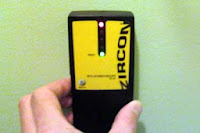Cut or tear off a piece of the damaged armrest cover. Visit a piece goods store and find the upholstery section. Show them the old material and ask them if they have anything similar in texture and color. For my repair, I purchased a yard of marine grade vinyl, which is used to recover boat seats, for under $8.00. In retrospect, a third of a yard should be plenty of material unless you are prone to accidents.
Lift the armrest cover to expose the inside of the console storage compartment. On the hinge in the back, you will see three Phillips head screws. Remove all three and place them in a cup holder. You won't need these screws again until you re-install the armrest cover.
Place the armrest cover with the bottom side facing up on a hard, flat surface. Around the perimeter of the cover, you will see nine Phillips head screws. Carefully remove each of these and place them in a safe location. Remove the plastic panel to expose the interior of the armrest cover. You should see a series of small staples that hold the vinyl material firmly in each of the corners.
Very carefully pry these staples out of the plastic armrest base. If the plastic base is old, it may have become brittle and you don't want to crack it. When all staples are removed, throw them away and remove the outer vinyl cover. Inspect the underlying foam material. If it looks OK, don't worry about replacing it.
Spread out the new vinyl material faced down on the flat surface and place the old vinyl material on top of it. Stretch it out as much as you can and trace the outline onto the new material using a pencil or pen. As long as you can recreate the basic shape of the original material, it should work. Don't worry if your new design is not as perfect as the original. It would actually benefit you to add up to an inch along the longer sides. Try to make the front and back of the new material match the original as closely as possible, though. Don't worry about cutting holes for the screws. They will punch through the material when you screw them back in. Using a pair of sharp scissors, cut out the shape that you traced.
Cut two inch-long pieces of double stick tape and apply them to the plastic base, just inside the rear section. Lay the plastic base upside down on the new material and stretch the piece that corresponds to the back of the armrest so that it sticks to the tape. Now, place two small pieces of tape inside the front of the base. Lift the entire base and stretch the material towards the front. When the material is as tight as you can get it, fold it firmly onto the tape.
Flip the armrest right-side up and inspect your work so far. Does it feel tight? Are there any wrinkles? If there is anything that doesn't pass your inspection, remove the material and adjust it. After the next step, it will be harder and more aggravating to fix earlier mistakes.
Place the armrest upside-down again and apply pieces of tape just inside each corner. Stretch and fold the corners of the material so that they overlap and contour the corner very tightly. Fold each one so that they stick firmly to the tape. When the corners are done, apply tape to the sides and repeat the procedure.
 Inspect the armrest cover once last time from above. The material should be stretched tightly around the entire perimeter of the armrest. The front corners should look round. Make sure there isn't any material sticking out that could interfere with the cover's opening and closing. If everything looks good, place the plastic panel back onto the underside of the cover and replace each Phillips screw.
Inspect the armrest cover once last time from above. The material should be stretched tightly around the entire perimeter of the armrest. The front corners should look round. Make sure there isn't any material sticking out that could interfere with the cover's opening and closing. If everything looks good, place the plastic panel back onto the underside of the cover and replace each Phillips screw.
Take the newly-covered armrest back to the Explorer and replace the three Phillips screws that you left in the cup holder back into the hinge. Open and close the armrest cover to make sure it has clearance on both sides.
Related articles
How to Find the Door Security Code for a Ford Explorer








